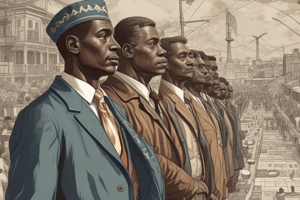Podcast
Questions and Answers
Match the following events with the correct outcome:
Match the following events with the correct outcome:
Plessy vs Ferguson = Allowed 'separate but equal' education Brown vs Board of Education = Overturned Plessy vs Ferguson Montgomery Bus Boycott = Lasted for 381 days March on Washington = Led to the Civil Rights Act
Match the following individuals with their actions:
Match the following individuals with their actions:
Rosa Parks = Refused to give up her seat on a bus Dr. Martin Luther King Jr = Believed in peaceful protest Ronald Reagan = Helped to end the Cold War None of the above = Implemented Reaganomics
Match the following terms with their meanings:
Match the following terms with their meanings:
Perestroika = Economic reform in the Soviet Union Reaganomics = Economic policy of Ronald Reagan Desegregation = Ending segregation in public education Cold War = A period of political tension between the US and USSR
Match the following events with their time periods:
Match the following events with their time periods:
Match the following individuals with their occupations before becoming president:
Match the following individuals with their occupations before becoming president:
Match the following laws with their effects:
Match the following laws with their effects:
Match the following events with their significance:
Match the following events with their significance:
Match the following terms with their significance in the Cold War:
Match the following terms with their significance in the Cold War:
Match the following individuals with their beliefs:
Match the following individuals with their beliefs:
Match the following laws with their effects on education:
Match the following laws with their effects on education:
Flashcards are hidden until you start studying
Study Notes
Civil Rights Movement
- Plessy vs Ferguson (1896) allowed "separate but equal" education, leading to segregation in public education
- Brown vs Board of Education (1954) overturned Plessy vs Ferguson, but schools were slow to desegregate due to lack of government deadlines
- Rosa Parks' defiance in 1955 led to the 381-day Montgomery Bus Boycott
- Dr. Martin Luther King Jr. advocated for peaceful protest and social change without violence
- The March on Washington (1963) resulted in leaders meeting with the President, ultimately leading to the Civil Rights Act of 1964
- The Civil Rights Act ended discrimination based on race, color, religion, sex, or national origin, ensuring equal access to public accommodations and fair job hiring practices
Reagan Era
- Ronald Reagan is known for his economic policy, "Reaganomics"
- Reagan played a key role in ending the Cold War
- Before presidency, Reagan was an actor and Governor of California
Post-Cold War
- Perestroika (Economic Restructuring) allowed ordinary people to have more control over Russian businesses and own their own businesses again
- Glasnost (Openness) gave people freedom of speech in the Soviet Union
- Reagan's "Peace through Strength" strategy involved having the best weapons to deter attacks, making others afraid to attack
- The Intermediate-range Nuclear Forces Treaty (INF) was signed by the US and Russia, eliminating INF and promising not to attack each other
- The US maintained its powerful defensive weapons but pledged not to use them
Perestroika
- Allowed ordinary people to have more control over Russian businesses
- Enabled individuals to own their own businesses again in the Soviet Union
- Implemented as part of economic restructuring in the Soviet Union
Glasnost
- Translates to "openness"
- Gave people freedom of speech in the Soviet Union
- Contributed to increased transparency and openness in Soviet society
Reagan's "Peace through Strength" Strategy
- Aimed to make the US military strong enough to deter attacks from other nations
- Intended to create a strong defense to maintain peace
- Successfully helped end the Cold War by making the US a formidable opponent
Intermediate-range Nuclear Forces (INF) Treaty
- Signed by both Russia and the US
- Required both nations to eliminate their intermediate-range nuclear forces
- Promised mutual non-aggression and reduced the threat of nuclear war between the two nations
- Allowed the US to maintain its powerful weapons for defense, but with a commitment not to use them
Civil Rights Movement
- Plessy vs Ferguson (1896) allowed "separate but equal" education, leading to segregation in public education
- Brown vs Board of Education (1954) overturned Plessy vs Ferguson, but schools were slow to desegregate due to lack of government deadlines
- Rosa Parks' defiance in 1955 led to the 381-day Montgomery Bus Boycott
- Dr. Martin Luther King Jr. advocated for peaceful protest and social change without violence
- The March on Washington (1963) resulted in leaders meeting with the President, ultimately leading to the Civil Rights Act of 1964
- The Civil Rights Act ended discrimination based on race, color, religion, sex, or national origin, ensuring equal access to public accommodations and fair job hiring practices
Reagan Era
- Ronald Reagan is known for his economic policy, "Reaganomics"
- Reagan played a key role in ending the Cold War
- Before presidency, Reagan was an actor and Governor of California
Post-Cold War
- Perestroika (Economic Restructuring) allowed ordinary people to have more control over Russian businesses and own their own businesses again
- Glasnost (Openness) gave people freedom of speech in the Soviet Union
- Reagan's "Peace through Strength" strategy involved having the best weapons to deter attacks, making others afraid to attack
- The Intermediate-range Nuclear Forces Treaty (INF) was signed by the US and Russia, eliminating INF and promising not to attack each other
- The US maintained its powerful defensive weapons but pledged not to use them
Studying That Suits You
Use AI to generate personalized quizzes and flashcards to suit your learning preferences.




